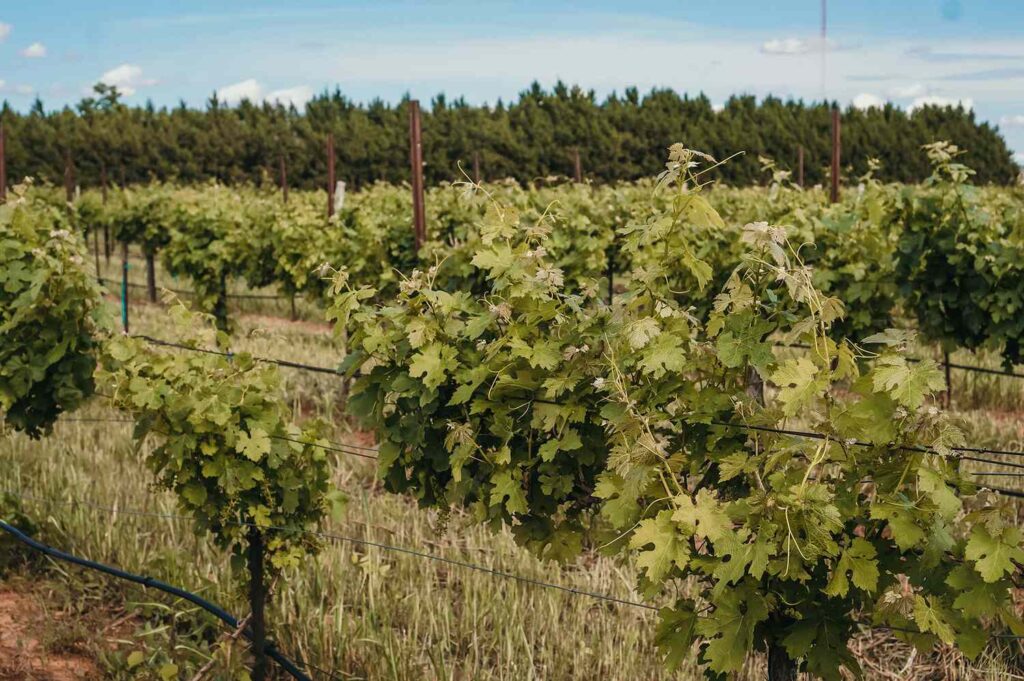The Llano Estacado is a high mesa in the southern part (that’s where the Texas Panhandle juts out like a smokestack). It’s characterized by rolling prairies that stretch as far as the eyes can see. You’ll find fields of cotton, peanuts and corn bursting along the highways. However, what most people might not know is that the fields here are also full of grapes, and you can find one of the largest wine grape-growing regions in Texas—and the U.S.—right here.
Known as the High Plains American Viticultural Area, this area produces 80 percent of all the wine grapes grown in Texas, far outpacing its more well-known sibling, the Texas Hill Country. The High Plains AVA, which is second in size (after the Hill Country), encompasses approximately 8 million acres.
The Panhandle may appear flat but its elevation gradually rises as you move west. It can range anywhere from 2,800 to 4,00 feet above sea-level. This combination of high elevation, low to moderate amounts of rainfall, warm temperatures and dry conditions, creates a perfect environment for the growth of wine grapes.
Visit Lubbock
The cooler nights in the region help keep grapes fresh and balanced even with our hot climate, says Madison Regis White. She is a sommelier at McPherson CellarsA winery in Lubbock Texas. The low humidity also helps prevent issues with vines such as disease, pests and rot. Also, the sandy loam drains well and keeps the roots healthy.
Texas is, of course, known for its toasty summers—but those dry, hot days actually encourage grapes to mature and ripen to ideal sugar levels, which helps set the wines’ acidity. Grapes that thrive in the High Plains can withstand hail, spring frosts and even the unpredictable weather. The Llano Estacado is actually capable of supporting a wide diversity of grape varietals: over 75 kinds of wine grapes are grown here, including tempranillo, sangiovese, mourvèdre, cabernet sauvignon, viognier, and pinot noir.
The High Plains has been a wine-producing region since the 1970s. However, the AVA designation was only granted in 1993. The High Plains is home to vineyards that supply wine to wineries across the state. However, you can taste the best of the region right where it’s grown.
Llano Estacado Winery, the state’s second oldest winery and the oldest winery in the High Plains, was established in Lubbock in 1976 and frequently uses locally grown grapes, including in its “clay block” merlot—a gold medal winner at the 2024 Lone Star International Wine Competition. About 10 minutes outside of downtown, this winery features a tasting room as well as a charming patio to enjoy outdoor drinks. Winery tours are available to those who are interested.
The heart of Lubbock is where you will find McPherson Cellars, founded in honor winemaker Kim McPherson’s dad, Clinton “Doc”, McPherson. Doc McPherson was a pioneer for the modern Texas Wind Industry. Doc McPherson experimented with planting different kinds of grape varietals in the High Plains during the ‘60s to see which worked best in the hot, dry region and helped establish the High Plains AVA. McPherson Cellars primarily specializes in sangiovese, but you can also sip on whites and rosés here as well.
The High Plains also get plenty of love from Hill Country wineries—the Panhandle does, after all, produce the vast majority of the grapes grown in the state.
Jennifer Cernosek is the general manager at Bending Branch Winery in Texas. She says, “I am impressed by the Petit verdot we have received from Narra Vineyards. The grape variety thrives in the hot climate of Texas.” Comfort, Texas. “The layered flavors and rich notes of dark berries, black cherries and cranberries allow the Petit Verdot to stand out as a single variety wine.
Although this wine region has not been as well-known yet as Napa and Sonoma, it is steadily gaining recognition, awards, and accolades.
Regis White: “The Texas High Plains AVA proves it can stand up to the top wine regions of the world.” “Growers are gaining experience every year, vineyard acres continue to grow, and winemakers are improving their skills, producing wines that get better.”


